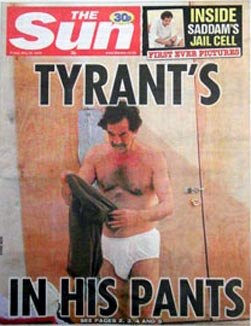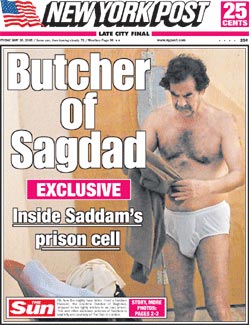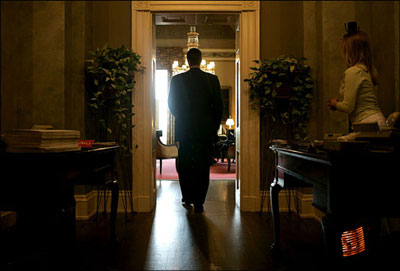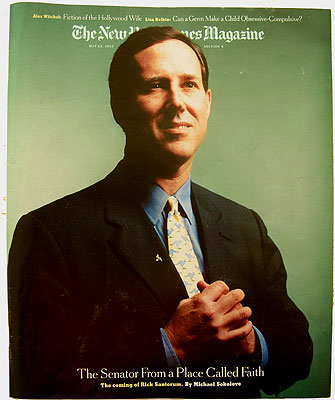Notes
Bottom Drawer Journalism

Enough of you have written for my opinion about the Saddam photos that I felt I shouldn’t disappoint.
My main reaction is the same one I had regarding Prince Harry in the Nazi costume: The more excited we get about these images, the more profit (and encouragement) we provide to News Corp., Rupert Murdoch and his entire sleaze operation.
But you’re not here to listen to my opinion on the tabloids. You’ve come to the BAG for a take on the image.
(In this instance, though, we probably need to consider not just the photograph but its overall composition. As a result, we really have two images, not one.)

So, let’s start there — with the two different covers.
I’m know I’m not saying anything profound in pointing out that the English are much more proper than we are. The Sun has Saddam set back, the type providing him a bit of cover. The Post shot is a close up, with the type and the background less in the way of the subject at hand. The different headlines follow the same pattern. The Sun is less hostile in its personal reference ("Tyrant" versus the cruder "Butcher"), with its double entendre actually dividing your attention between Saddam’s underpants and his slacks. The Post, on the other hand, is not only more graphic in its labeling, but the "Sagdad" term makes reference only to the underwear — or what’s under the unders. (By the way, I don’t get the "sag" slur. If it’s an anatomical dig, it seems Saddam actually holds up pretty well.)
The rest of my comments have to do with the cover of The Sun. (I focus there not for the sake of modesty but because it is truer to the actual photo.)
Despite the insistence by the Post that this picture is humiliating, it seems more the opposite. In fact, I believe there are a number of elements that not only soften it, but make it mundane and almost sympathetic.
If someone wanted to create a sense of humiliation, they would have captured an image of Saddam in which he appears to engage (and challenge) the camera. Instead, the fact he is looking down lends an air of modesty — not to mention, vulnerability. By catching Saddam so obviously unaware, the photo backfires. Rather than shaming the tyrant, it serves more to suggest that — with the surveillance capability out there — it could just as easily be one of us. Also, if the Post had other pictures to choose from, they made a mistake choosing this one. The act of folding ones’ pants couldn’t be more humanizing. At the same time, it simply goes against type seeing "the Butcher" taking such care while attending to housekeeping.
The domestic nature of this picture extends even farther, though. The Post story goes out of it’s way to emphasize Saddam’s limited quarters and meager surroundings. Twice in the first three short paragraphs of their story, the Post emphasizes that the former dictator has been relegated to a dingy, overly confined cell. That may be the case, but how often have you imagined a cell with a solid wood door — especially one with a lock on the inside.
With the lock involved, some confounding associations arise. For example, it implies that this space is one Saddam controls and has digression over. Cognitively then, the setting is more suggestive of a bedroom or a hotel room — as opposed to a tiny "four walled" prison cell. And with this higher level of ownership and domesticity comes a higher expectation of privacy. As a result, it makes our involvement that much more invasive. (So much so that it heightened the negative reaction to the picture …and made these newspapers look that much more perverted.)
The other factor that softens the space is the wooden wall. I understand, on close inspection, that it’s probably cheap plywood. The visual impression, though, is distinctly un-cell-like, with the warmer color and the grain pattern just as suggestive of wood panelling. Of course, you could argue this is perfectly appropriate for a minimum security facility. But who holds the image of a minimum security facility in their head? Primarily what it does — at least visually — is to contradict the more familiar impression of the cell block.
What is also contradictory is the fact that the wood wall ends and a concrete wall begins (which you see at the far left of the photo). (Strangely, in the Post version, the concrete actually looks more like drywall.) This transition is confusing enough to suggest all kinds of possibilities. For a second, I thought the change in material made it look like a back-drop. Surely there must be plenty of people out there ready to believe that Saddam is on a movie set.
Finally, those pants don’t suggest confinement either. When you hear "prison," you think light cotton with a draw string — not your brown slacks from home.
(image 1: May 20, 2005. cnn.com; image 2: May 20, 2005. newyorkpost.com)


Reactions
Comments Powered by Disqus